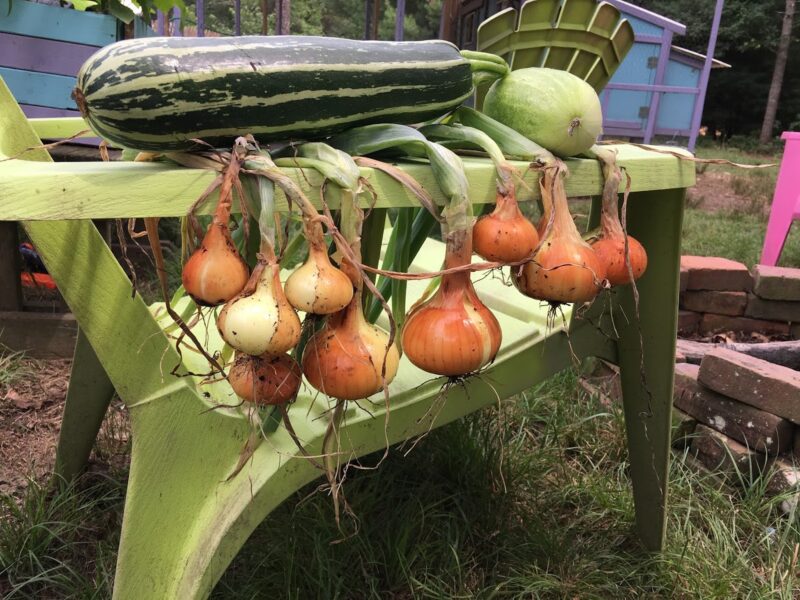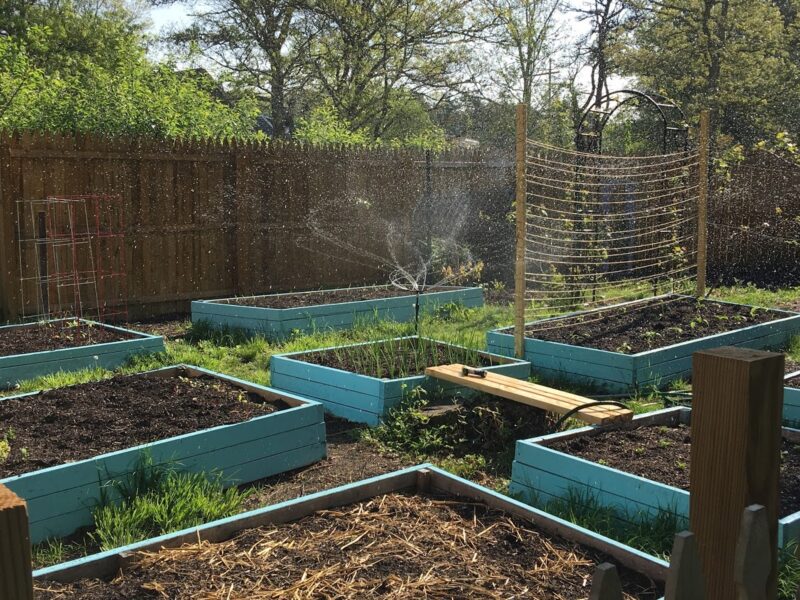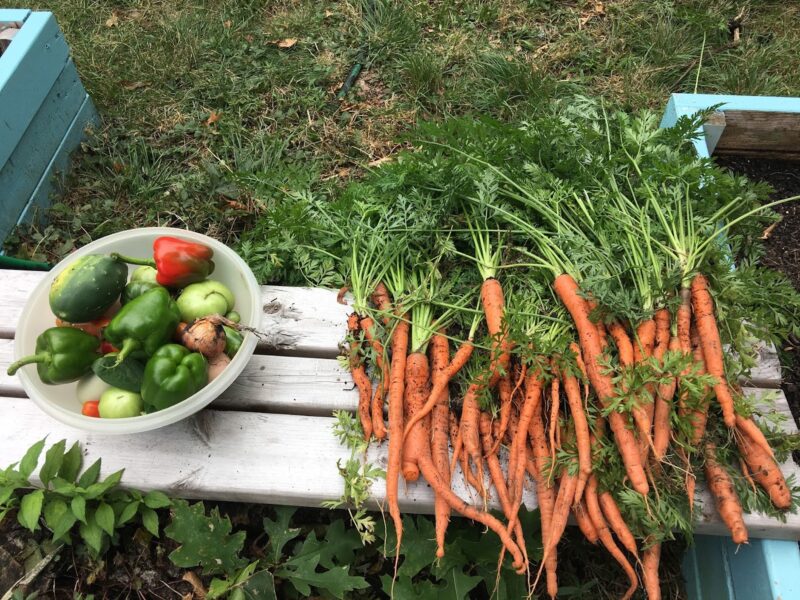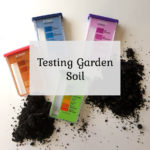---------------------------------------------------------
So you are ready to start your first garden? Congratulations! There is nothing more satisfying than growing your own food! It can also be incredibly difficult and frustrating, especially when you are first starting out. Check out these 7 beginner gardening mistakes to avoid.
Mistake #1 – Improper Garden Placement
This is probably the mistake most often made by beginners. Before you order those seeds, before you visit the nursery, before you even pick up that shovel you need to spend some time getting to know your yard.
Just because you want your garden conveniently located next to your back patio does not make it the perfect place for a garden. Getting to know your yard is crucial to success in growing food.
How does the sun travel your yard?
The first thing you need to research is the sun. Typically, the southern side of your house will give you the sunniest location for a garden in the northern hemisphere – but your yard might not be typical. You could have large trees or neighboring buildings shading your southern side. Spend the day in your yard noting how the sun travels across your yard and where shadows are cast.
Most vegetables and fruit require full sun to grow – meaning about 8 hours of direct sunlight. That could mean that your front yard, not your back yard is best for gardening. Some obstacles that provide shade are not possible to move – like your house, shed, or a large forest. But it might be possible for you can cut down a few trees to let the light in.
Where is your outdoor water source?
Another thing to consider is having a convenient water source. If you have to haul water to your garden you will be far less likely to water it. Ideally, locate your garden near an outdoor spigot. The sunniest spot in your yard could be located on the opposite side of the yard as your water spigot. In that case, your choices are to call a plumber and have a new line run, or get a really long hose.
Where can you most easily visit your garden?
The last key to garden placement is convenience for the gardener. If your garden is tucked into the far corner of your yard you might be tempted to ignore it, or be less likely to notice when your produce is ready to be harvested causing it to spoil. So you need to find that sweet spot in your yard that balances direct sunlight, proximity to water, and is conveniently located.

Mistake #2 – Improper Soil Preparation
Now that you have found the perfect location for your garden, don’t forget to check into the soil there. Doing a simple soil test will tell you exactly what you are working with and what you can do to improve it for superstar plants. Soil is made up of minerals, organic matter, air, and water. The strength of these elements will directly impact the health and vitality of your plants. click here to learn more about testing soil
Soil Minerals
Soil test kits are available at most garden centers or hardware stores. You can also send a sample to your local extension office for testing (although this can sometimes take weeks to get results).
Test kits will test your soil’s pH levels and will give you results in a range of 0-14. Most vegetables prefer a fairly neutral pH of 6 to 7. Acidic soil tends to be low in calcium and magnesium, some of the basic building blocks of healthy plants. Alkaline soil can make it hard for plants to take in important minerals like iron.
There are also commercial tests you can do at home to test for minerals your soil might be lacking. You can use the results of your tests to improve the soil conditions by adding lime to acidic soil, soil conditioners/compost to alkaline soil, or adding amendments to replace missing minerals.
DIY soil pH test
It is possible to test your soil ph without a kit, using ingredients you likely have in your kitchen. To do this, collect soil samples from around your garden (dig down about 6 inches in a couple of areas of the garden to collect the soil). You will want to have about 1 cup of soil.
Take a couple of spoonfuls of soil and put it in a glass cup. Add 1/2 cup of vinegar. If it gets all bubbly and fizzy, you have alkaline soil, likely around a 7 or 8 on the pH scale. Take a couple of more spoonfuls and put it in a different glass cup. Slowly add distilled water to the cup until you have a muddy mix (it is important to use distilled water not tap water so you aren’t picking up the pH of your tap water). Once you have muddy water, add 1/2 cup baking soda. If it bubbles and fizzes you have acidic soil, likely around a 5 or 6 on the pH scale. If you didn’t get reactions from either test, you have neutral soil. Improving soil conditions is a long process that can take years. Little changes, year by year will eventually give you super fertile, amazing soil.
Organic Matter in your soil
Many of the nutrients your plants need come from decomposing matter in the soil. You can buy commercial fertilizers that mimic compounds found in organic matter to add to your soil. You can also use natural sources like composted leaves, animal manure, or food scraps.
This is where learning about composting can become invaluable for gardeners. Compost is made of decayed organic materials and is like a superfood for your plants. If you can make your own it is free! Even if you start out with soil rich in organic matter, as your plants grow they will use up that organic matter. Eventually, the soil will be barren unless the organic matter can be replaced. Click here to learn more about making your own compost. Adding new organic matter to your garden should be an annual chore.
Air for your soil
Air is an essential ingredient in fertile soil. Air is important for the animals (like worms) and healthy bacteria that live in the soil to breathe. These organisms are important in your soil as they are continually working, eating organic materials, and turning it into food your plants can absorb. Your plant’s roots also need oxygen to grow. You can introduce air to your soil by tilling the ground and being careful not to walk in areas with plants, compacting the soil.
Water
Life can not exist without water – keeping the ground evenly moist is vital for your plants. Too little water in the soil and your plants will die, too much water and the roots will rot
What if your soil is horrible and you don’t want to wait years to fix it?
Is the native soil in your yard not up to snuff? Raised bed gardens are a great way to ensure you have quality soil, ready for gardening. Click here to read about building an inexpensive raised garden bed
Mistake #3 – Not researching the plants you are growing
While most vegetables like 8 hours of direct sunlight, and most like neutral soil – there are exceptions to every rule. Do your homework on the plants you are growing and you will see much higher yields at harvest time.
Tomatoes like full sun all day long, slightly acidic soil rich in nitrogen and calcium. Lettuce likes to have a little bit of shade or it can develop a bitter taste and it likes a more neutral soil. Beans like full sun, a slightly alkaline soil with less nitrogen than many other plants require. Too much nitrogen and the beans will spend too much time putting out leaves and not enough time setting beans. Some plants grow better in the south with high heat and need a longer growing season, some plants prefer the cooler northern growing climate.

Mistake #4 – Taking on more than you can handle
It’s so hard to not get caught up when flipping through seed catalogs! But gardening is a skill best developed over time. In your first year, focus on growing 2-3 of your family’s favorite vegetables. The next year add some more. The fastest way to feel like a failure is to have small or no yields in return for your time & money spent.
If you start with 10 garden beds with 30 different kinds of plants and you don’t have the time to keep up with the weeds, your vines aren’t producing fruit, or your veggies are left to spoil in the garden because you don’t have time to harvest it, of course you will be discouraged! Start slow and grow along with your garden.
Mistake #5 – Watering too much
Everyone knows plants need water to grow. In their excitement, many new gardeners water their garden too much. More water will not make your plants grow healthier or faster. Growing in constantly wet soil will invite mold to kill the roots and fungus to grow on the leaves.
Watering every day also encourages your plants to set very shallow roots. If the water is right at the surface there is no need for the plant to develop a big, strong root system in search of water. That might not be a big deal for small lettuce plants. For big plants like tomatoes or squash, they need a large root system to support their growth. Shallow roots mean they will die at the first sign of drought.
Look at how nature waters plants with rain. Less frequently but for longer periods. The best way to water your garden is 1-3 times per week (depending on how much rain you are getting and how hot it is), and to water deeply each time.
Just as important as how much, is when you water. Watering first thing in the morning is best. If you water in the heat of the afternoon, water left on leaves can magnify the sun, burning the leaves. If you water in the evening, the sun can’t evaporate excess water, inviting fungus & mold growth.

Mistake #6 – Fertilizing too much or at the wrong times
Adding fertilizer, either with natural amendments or store-bought fertilizer, is necessary for plants to produce to their full potential. But adding the right amount of fertilizer and adding it at the time the plant needs it most is critical. This goes back to mistake #3, make sure you research what the best kind of fertilizer is for the plants you are growing and when to apply it.
Nitrogen rich fertilizer is important for growing healthy leaves and large plants, but at some point you want those plants to stop growing leaves and start flowering to set fruit. When tomatoes are setting fruit, it requires a lot of calcium. If they can’t get enough from the soil during this time, the fruit will develop black rot spots on the ends. Perennial fruit bushes like blueberries or grape vines would appreciate a boost of fertilizer when they start to wake up in the spring. If you feed them in the fall, they will put out lots of new growth only to have it killed with winter’s frost.
Mistake #7 – Being too hard on yourself
Did your garden all die the first year? Mine did too, Year two wasn’t that spectacular either. I still can’t manage to grow broccoli even though everyone swears it’s easy. There is definitely an art to growing food and it’s not something most people pick up in a couple months of gardening. Add in the unpredictability of nature and the best-laid plans can easily go astray.
Don’t give up! Learn the lessons from season one and season two will be even better – and the next year will be even better than that! No one’s garden is going to be perfect – weeds grow 3 feet overnight, the summer will be cooler or hotter than expected, it will rain every day for two weeks straight. Things happen, but you have to just dust that compost off and get back in the game!







Grace
Saturday 18th of April 2020
Lovely posts!